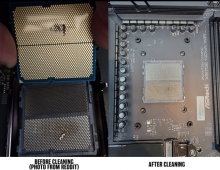
New ATI Stream SDK Brings Enhancements For Developers
AMD today announced the availability of the ATI Stream Software Development Kit (SDK) v2.1, the latest update of its ATI Stream SDK supporting OpenCL industry standard-based programming on AMD GPUs and x86 CPUs.
ATI Stream SDK helps developers accelerate application performance by leveraging the CPU and GPU resources in a given system. This collaborative computing model will be enhanced in the upcoming AMD Fusion Family of accelerated processing units (APUs). The new version brings additional performance-enhancing features, increases ease-of-programming and expands hardware support, and is available for download today.
"With the anticipated arrival of the AMD Fusion Family of APUs next year, we can support developers who want to begin creating next-generation software experiences for APUs now," said Ben Bar-Haim, general manager AMD Canada and corporate vice president of Software Engineering, AMD. "The ATI Stream SDK puts the developer community on the path to success by providing access to the CPU and GPU system resources already available to them today."
New features supported by the ATI Stream SDK v2.1 include:
* Support for OpenCL / OpenGL interoperability, helping reduce the overhead of passing data for display purposes.
* Support for OpenCL byte addressable stores allowing more natural and efficient code for applications, such as image processing, that depend on the ability to update data at smaller than 32-bit granularities.
* Support for OpenCL images, providing developers with access to hardware-accelerated texture features on AMD GPUs.
* OpenCL extension support for AMD media operations in OpenCL, giving developers a set of OpenCL kernel operations commonly used in multimedia applications.
* OpenCL extension support for device fission in OpenCL, enabling developers to sub-divide an OpenCL device and allowing multiple work kernels to be assigned to that device.
* Integration of Stream KernelAnalyzer 1.5 installer, which helps developers to statically analyze OpenCL kernel performance on AMD graphics processors. * Support for next-generation ATI FirePro professional graphics cards.
AMD Fusion represents a new approach to processor design and software development, delivering serial, parallel and visual compute capabilities for todays HD video, 3D and data-intensive workloads in a single-die processor called an Accelerated Processing Unit (APU). APUs combine high-performance serial and parallel processing cores with other special-purpose hardware accelerators.
"With the anticipated arrival of the AMD Fusion Family of APUs next year, we can support developers who want to begin creating next-generation software experiences for APUs now," said Ben Bar-Haim, general manager AMD Canada and corporate vice president of Software Engineering, AMD. "The ATI Stream SDK puts the developer community on the path to success by providing access to the CPU and GPU system resources already available to them today."
New features supported by the ATI Stream SDK v2.1 include:
* Support for OpenCL / OpenGL interoperability, helping reduce the overhead of passing data for display purposes.
* Support for OpenCL byte addressable stores allowing more natural and efficient code for applications, such as image processing, that depend on the ability to update data at smaller than 32-bit granularities.
* Support for OpenCL images, providing developers with access to hardware-accelerated texture features on AMD GPUs.
* OpenCL extension support for AMD media operations in OpenCL, giving developers a set of OpenCL kernel operations commonly used in multimedia applications.
* OpenCL extension support for device fission in OpenCL, enabling developers to sub-divide an OpenCL device and allowing multiple work kernels to be assigned to that device.
* Integration of Stream KernelAnalyzer 1.5 installer, which helps developers to statically analyze OpenCL kernel performance on AMD graphics processors. * Support for next-generation ATI FirePro professional graphics cards.
AMD Fusion represents a new approach to processor design and software development, delivering serial, parallel and visual compute capabilities for todays HD video, 3D and data-intensive workloads in a single-die processor called an Accelerated Processing Unit (APU). APUs combine high-performance serial and parallel processing cores with other special-purpose hardware accelerators.





















